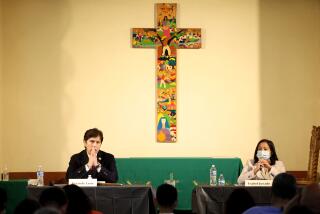Gang programs: L.A.’s anti-gang efforts are working
The Times’ April 3 article “Mayor Villaraigosa defends L.A. anti-gang program” mischaracterizes the findings of a study last year by the Urban Institute. Casting doubt on L.A. Mayor Antonio Villaraigosa’s claims about the success of the office of Gang Reduction and Youth Development (GRYD), the article misleadingly suggests that the GRYD is ineffective by stating that the study claims “there was no evidence that [GRYD] was responsible for the decline in violent crime.”
The study actually concluded that data limitations precluded direct correlations between the GRYD and crime reduction -- but these same limitations also apply to all crime-impacting factors, including policing and demographics, suggesting that joint efforts by multiple offices and groups in the city are behind the city’s seven years of violent crime-rate reduction. The study is clear that the GRYD is succeeding at a level to be expected. And we know that entrenched violence dynamics, such as those in L.A., require sustained and long-term intervention efforts. GRYD programming is too new for definitive findings.
In any event, such a finding cannot accurately be used to impugn the mayor’s broader claim that the GRYD is one of the city’s most effective programs, taking a comprehensive approach to reducing gang violence and crime and, more importantly, to seeding safer neighborhoods in gang zones.
Analysis done by my group, the Advancement Project, of crime data from 2006-10 clearly shows the substantial impact of the GRYD’s Summer Night Lights (SNL) program, which keeps parks in gang-plagued neighborhoods open at night during the summer. In a comparison of city and non-city park programs that examined crime data within a quarter mile of each “gang” park, the number of gunshots fired in and around SNL parks plummeted 53%; for non-SNL parks, the reduction was 6%. For parks with non-city gang-reduction programs, the number of shots fired plummeted by 38%. Gang-related crimes decreased by 33% in SNL parks but actually increased by 0.6% in city parks without SNL. And finally, as The Times noted in a 2010 editorial, homicides in SNL parks plunged by 57%, a remarkable feat that no other area came close to achieving.
The Advancement Project’s full report is forthcoming, but there is no doubt that comparative crime data show the GRYD’s success in implementing a comprehensive violence reduction strategy. The Times article’s characterization of the joint efforts by the GRYD, the community and the Los Angeles Police Department as having little impact on crime is flat wrong.
Much work remains to be done before gang zones are safe for all kids. But the mayor is right: Interrupting violence and transforming parks into vibrant centers of neighborhood activity require joint efforts led by a focused and accountable office. Do the GRYD, gang zone communities, law enforcement, schools and advocates like the Advancement Project have a long way to go? Yes.
But impugning the significant progress made by communities under GRYD programs is harmful and irresponsible. What we have not yet established is whether, over time, at-risk kids who are served with prevention efforts like the GYRD’s stop joining their neighborhood gangs. Only time and continued comprehensive efforts will tell.
Connie Rice, a civil-rights attorney in Los Angeles, is co-director of the Advancement Project.
If you would like to write a full-length response to a recent Times article, editorial or Op-Ed and would like to participate in Blowback, here are our FAQs and submission policy.
ALSO:
Painkiller addiction: Is it really an epidemic?
Fossil-fuel subsidies: Helping the richest get richer
More to Read
A cure for the common opinion
Get thought-provoking perspectives with our weekly newsletter.
You may occasionally receive promotional content from the Los Angeles Times.










